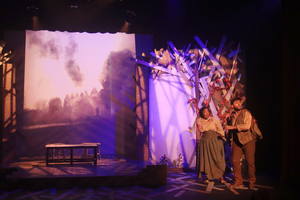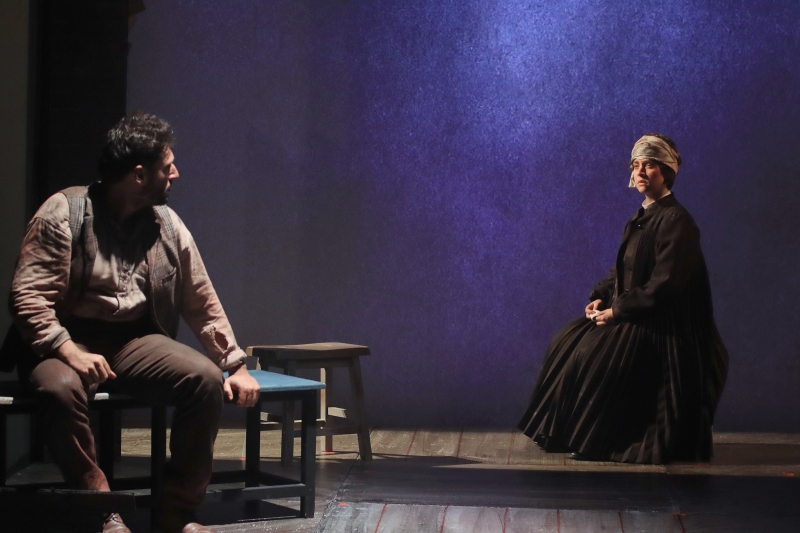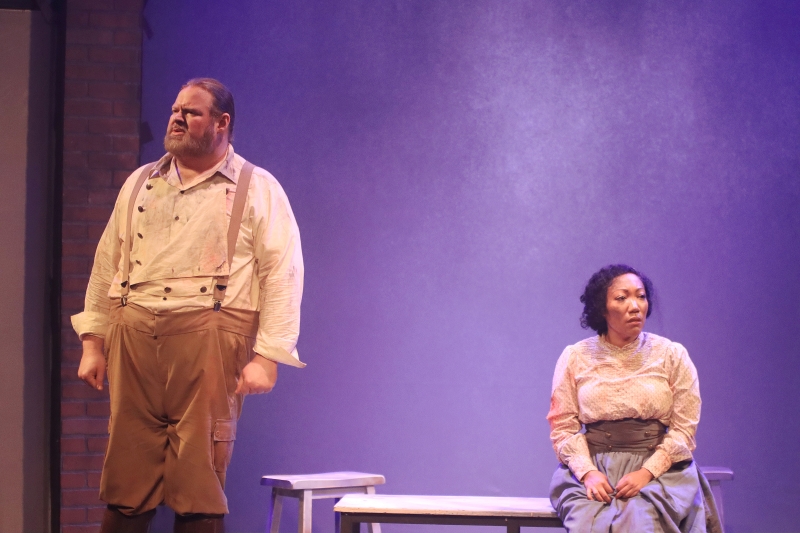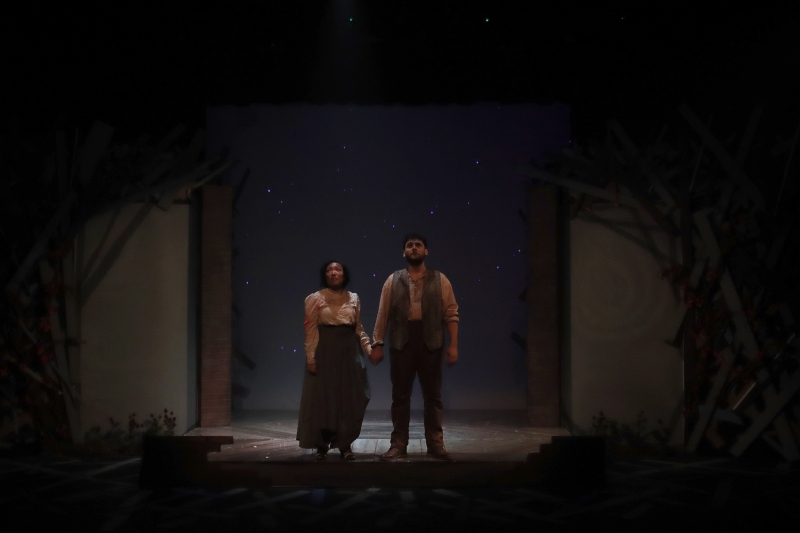Review: THE WAR OF THE WORLDS at Classical Theatre Company is a Science Fiction Odyssey
Classic sci-fi fans, gather round!

Fans of old school science fiction (particularly the thoughtful, novelistic kind that prefigured The Twilight Zone and Star Trek) should find much to enjoy the Classical Theatre Company's adaptation of H.G. Wells's famous 1898 novel, The War of the Worlds. This production, while only occasionally striking a successfully ominous tone, gives weight to the confusion and terror of having one's world upended by a force too powerful to fight.
Following the story of a Martian invasion of Earth in the mid-1800s, Wells's novel deals with the fallout after an alien pod crashes down in the pastoral English town of Woking, unleashing a barrage of horrors from the stars. However, by modern day narrative standards, the story bears a closer resemblance to war narratives, focusing more on the trials and difficulties of the survivors than the strangeness of the invaders. The story is less concerned with the phantasmagoria of the alien and unknown and more concerned with the humanity of having one's home destroyed, violently and without warning.
The narrative is anchored in the journey of two ordinary Earthlings, a man named George and his wife Jane. The two are living in Woking, Surrey when the Martians land, and are among the first two to see them. They are quickly forced to flee as the Martian technology proves vastly superior to the guns and cannons that the Englishmen bring against them, and the couple take to the countryside. However, they are soon separated and forced to survive on their own.

Photography by Pin Lim
George soon meets a severely traumatized Curate with whom he shelters in an abandoned farmhouse, while Jane is rescued by an "Artillery Man" with dreams of creating a new society underground and eventually taking Earth back from the Martians. During this section of the story, the initial horror of the invasion begins to give way to despair as we see the true psychological impact of the Martian invasion on the survivors. The pacing also improves during this section, as the dialogue switches from narration drawn from the original novel to actual interactions between characters, collapsing the sense of distance that one has sensed between the characters up to this point.
Adaptor Chris Iannacone has done much to deepen the characters. In Wells's novel, George is simply an unnamed narrator, while his wife is a much more ancillary character. However, Iannocone has wisely humanized them and fashioned them as co-protagonists, giving a portion of the narrator's story to Jane. For example, in this adaptation it is Jane who catches the first glimpse of the Martians in their unarmoured form. In addition, the original novel has the narrator living with the Artillery Man after the Curate has been taken by the Martians. This adaptation has Jane take his place, which serves not only to improve her role in the narrative and endow her with more of a voice, but also collapses the two parts of the story so that they occur simultaneously, allowing the audience to draw parallels between George's struggles and Jane's.

Photography by Pin Lim
These changes are rewarded at the climax of the play when George and Jane, nearly devoid of all hope, travel into London in search of other survivors and find each other near an unmoving Martian war machine. Audience members during the performance I attended reacted with audible "aw"s at watching the pair reunite after struggling so much apart.
The story ends with the Martians dying off, seemingly due to exposure to Earthly pathogens to which humans had built up an immunity. The survivors are quickly able to begin rebuilding society, but retain a sense of anxiety that more Martians may come to finish what their comrades could not. We are left on an ominous, yet hopeful beat, with George and Jane reminding us to never take for granted our safety and superiority.
Throughout the play, much of the dialogue is told through narration, which can at times become stilted, though attempts are made to subvert this by using lights, sounds, and projections to simulate the Martian technology. The projections utilize shadow puppetry (a collaboration between puppet advisor Justin Dunford, lighting designer and video editor Edgar Guajardo, and puppet master Kalob Martinez) to give us a visual of the aliens. While the execution occasionally leaves something to be desired, I admire the impulse of trying to evoke the images in Wells's novel in a way that does not dispel but creates space for disbelief.
The sound effects, done by sound designer Jon Harvey, are more successful. The eerie sounds that Harvey generates remind one why Orson Welles's radio adaptation was so successful; it may be difficult to generate visuals that effectively evoke the otherworldly, but the aural can be much more easily manipulated. Plus, the ominous effect is greater when we can only partially locate something. (Why do you think creaking floorboards are such a staple of the horror genre?)

Photography by Pin Lim
As for the performances, Gabriel Regojo and Callina Anderson are both in good form as George and Jane, although the fact that so much of their dialogue is narration deprives them of the opportunity to fully connect with one another and occasionally gives their performances a more reserved air. Jeff McMorrough and Shanae'a Moore are more unencumbered by these requirements, and are able to more fully inhabit their situations. Moore is particularly excellent as the Curate, whose mental breakdown gives voice to the psyche-shattering trauma that the invasion incites.
Of course, it is hard not to draw parallels between a story about invasion and colonization and current events taking place in Ukraine. While this adaptation does not draw these parallels itself, one cannot help but take from the final monologue a mandate to not take for granted the securities that we enjoy and to understand the horrors that may come, not from the sky, but from our own Earthly neighbors. Wells himself was particularly interested in the British colonization of Tazmania when he wrote the novel, and the story contains echoes of those themes. Namely, what does it mean to have your entire existence upended by an outside force that views you as expendable? More importantly, what does it mean to be powerless to defend yourself against such forces.
This adaptation, for its flaws, maintains that humanity and suspense throughout. It stands as a strong reminder of the potential for science fiction to tell deeply humane stories, using otherworldly lenses to better understand our own world. This production manges to keep these elements just balance enough that one walks away not only with the satisfaction of having consumed a hearty theatrical meal, but a renewed urge to ponder our place in this world.
The War of the Worlds is now running at the DeLuxe Theatre, located at 3303 Lyons Avenue. The production runs through May 1, with post-show talkbacks being held after every Sunday matinee. Tickets are $25 for adults, $20 for seniors, and $10 for students or teachers. For tickets, visit www.classicaltheatre.org or contact the box office at (713) 963-9665.
Reader Reviews

Videos

